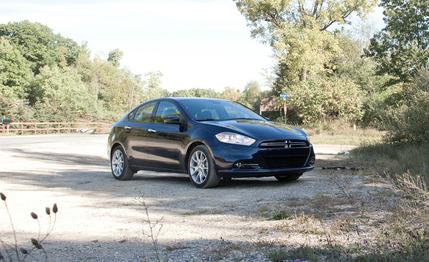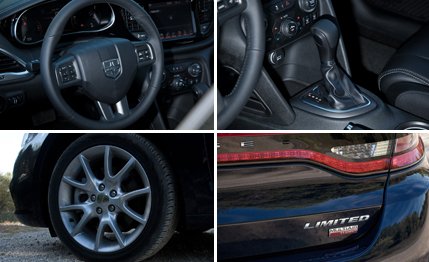
 Instrumented Test
Instrumented Test


On paper, a turbocharged engine, a dual-clutch automatic gearbox, and an Italian-derived platform—like those found in Chrysler’s new Dodge Dart—sound like nice ingredients for a modern, fun-to-drive compact sedan. In this case, however—well, you might see where we’re going here.
Just Go, Already
Labeled DDCT for “dual-dry-clutch transmission,” the Dart’s six-speed setup is offered as an $1100 extra on models equipped with the 1.4-liter MultiAir turbocharged four—itself a $1300 option over the standard 2.0-liter engine. Both powerplants make the same 160 hp, but the port-injected 1.4 turbo produces 36 additional lb-ft of torque for a total of 184. Unfortunately for the heavy Dart—3338 pounds as tested— the 1.4-liter turbo’s peak torque comes at a relatively high 2500 rpm. The DDCT is the Dart 1.4’s sole auto-shifting option, but unlike the synaptic-shifting dual-clutch gearboxes in many VW/Audi and Porsche cars, this one feels programmed to mimic the mushiness of a conventional torque-converter automatic. If we wanted one of those, we’d opt for the Dodge’s base engine, which is available with a conventional six-speed autobox.
The Dart’s 1.4 MultiAir four is similar to that in the Fiat 500 Abarth, which is nearly 800 pounds lighter and less affected by the little four’s substantial turbo lag and dearth of low-end power. The standard manual transmission offers the driver more flexibility to keep the engine in its power band, but the DDCT upshifts early for efficiency and hesitates whenever you put your right foot down. Combined with a much heavier car, there’s a lot of twiddling of thumbs before sufficient boost is available.


Our rather portly Limited-grade tester weighed 72 more pounds than the last 1.4 we evaluated with the standard six-speed manual. It was also significantly slower with our testing equipment onboard. The manual car needed 7.9 seconds to reach 60 mph and 16 flat to cover the quarter-mile, but the DDCT stretched those times to a lazy 9.0 and 17.1 seconds. Lined up against a roster of recently updated competitors, that’s enough to push the Dart from midpack to the back of the field in a drag race, besting only the refreshed-for-2013 Nissan Sentra.


The sluggishness might be made more palatable with fuel-economy improvements, but the DDCT model can’t improve on the manual car’s 27-mpg city figure and actually comes in 2 mpg lower on the highway, at 37 mpg. Our combined figure of 26 mpg was a product of our usual spirited driving, but it illustrates how hard the DDCT makes the turbo mill work to keep the sedan moving. In comparison, we have averaged 28 mpg with two different, and equally thrashed, 1.4 manual models.
’At’s-a Nice
If there is one big positive, the Alfa Romeo–based chassis underpinning the Dart is solid and offers good road feel. Our car’s 178-foot stopping effort and 0.84 g of grip around the skidpad on 17-inch Continental all-season tires were respectable, although rather softly sprung suspenders made for a large dose of body roll and had us moving around excessively in the short-cushioned, unsupportive front seats.


We’ll count the Dart’s cabin as another positive—it’s one of the largest in the segment and is so roomy that the car is classified as mid-size by the EPA. The interior is not as attractive to our eyes and hands as that of the 10Best Cars–winning Ford Focus, but soft-touch materials are in the right spots, and the ergonomics and the touch-screen interface are well executed. Our top-level Limited example started at $23,190 and finished at $26,765. That included the 1.4 and the DDCT, as well as the $995 Premium group (leather seating, heated steering wheel and front seats, remote start, and dual-zone climate control), a power sunroof ($895), Uconnect navigation with an 8.4-inch center touch screen ($495), and satellite radio ($195).
Our advice for those who desire an automatic and have their heart set on a Dart is to get the naturally aspirated 2.0-liter model or wait for the sporty R/T and its larger, 2.4-liter four and available conventional six-speed autobox. Or better yet, learn to drive a stick.